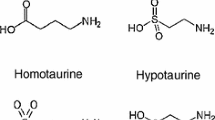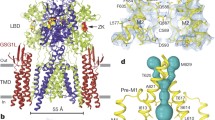Abstract
The antiepileptic drug riluzole is used as a therapeutic agent in amyotrophic lateral sclerosis due to its neuroprotective effects. Besides presynaptic inhibition of GABAergic and preferentially glutamatergic transmission, it also potentiates postsynaptic GABAA-receptor function. We investigated the postsynaptic effects of riluzole on GABAA-receptor channels by use of the patch-clamp technique. Recombinant α1β2γ2s and α1β2 GABAA receptors were expressed in HEK 293 cells by transient transfection. Pulses of GABA were applied in combination with different concentrations of riluzole to whole cell or outside-out patches with either α1β2γ2s or α1β2 GABAA-receptor channels. Co-application of riluzole led to a slight decrease of absolute peak current amplitudes and steady-state currents in prolonged presence of GABA at saturating concentrations. In the presence of riluzole, enhancement of current amplitudes was observed with lower concentrations of GABA at α1β2γ2s receptors and to a lower extent also at α1β2 receptors. Thus, the potentiating effect of riluzole was shown to be not abolished in the absence of the γ2s-subunit. A further prominent effect of riluzole was a highly significant acceleration of the time course of current decay, most probably pointing to an open-channel block-like mechanism of action. As both receptor subtypes were affected similarly by the block, it could be concluded that the respective binding sites should be assumed within a region of high sequence homology like it is given for the channel-lining M2 domain of GABAA-receptor subunits. In conclusion, three different molecular mechanisms of interaction of the neuroprotective compound riluzole were observed at two different subtypes of GABAA receptor channels. The results further point to the impact of the inhibitory as well as the excitatory synaptic activity as a pharmacological target to counteract chronic excitotoxicity and reveal molecular mechanisms of action of the only one neuroprotective drug in current clinical use in patients suffering from amyotrophic lateral sclerosis.








Similar content being viewed by others
Abbreviations
- ALS:
-
amyotrophic lateral sclerosis
- FCS:
-
fetal calf serum
- GABA:
-
γ-aminobutyric acid
- HEK cells:
-
human embryonic kidney cells
References
Bensimon G, Lacomblez L, Meininger V (1994) A controlled trial of riluzole in amyotrophic lateral sclerosis. ALS/Riluzole Study Group. N Engl J Med 330:585–591
Biro AA, Holderith NB, Nusser Z (2006) Release probability-dependent scaling of the postsynaptic responses at single hippocampal GABAergic synapses. J Neurosci 26(48):12487–96
Brown PN, Byrne GD, Hindmarsh AC (1989) VODE: a variable coefficient ODE solver. SIAM J Sci Stat Comput 10:1038–1051
Bufler J, Franke C, Parnas H, Dudel J (1996) Open channel block by physostigmine and procaine in embryonic-like nicotinic receptors of mouse muscle. Eur J Neurosci 8:677–687
Colquhoun D, Hawkes AD (1995) The principles of the stochastic interpretation of ion-channel mechanisms. In: Sakmann B, Neher E (eds) Single channel recording. Plenum, New York, pp 397–482
Farrant M, Nusser Z (2005) Variations on an inhibitory theme: phasic and tonic activation of GABA(A) receptors. Nat Rev Neurosci 6:215–229
Haas KF, Macdonald RL (1999) GABAA-receptor subunit gamma 2 and delta subtypes confer unique kinetic properties on recombinant GABAA-receptor currents in mouse fibroblasts. J Physiol 514(Pt 1):27–45
Hamill OP, Marty A, Neher E, Sakmann B, Sighworth FJ (1981) Improved patch-clamp techniques for high resolution current recording from cells and cell-free patches. Pfluegers Arch 391:85–100
He Y, Benz A, Fu T, Wang M, Covey DF, Zorumski CF, Mennerick S (2002) Neuroprotective agent riluzole potentiates postsynaptic GABAA-receptor function. Neuropharmacology 42:199–209
Heckmann M, Bufler J, Franke C, Dudel J (1996) Kinetics of homomeric GluR6 glutamate channels. Biophys J 71:1743–1750
Jahn K, Hertle I, Bufler J, Adelsberger H, Pestel E, Zieglgänsberger W, Dudel J, Franke C (1997) Activation kinetics and single channel properties of recombinant alpha1beta2gamma2L GABA(A) receptor channels. Neuroreport 8(16):3443–3446, Nov 10
Jehle T, Bauer J, Blauth E, Hummel A, Darstein M, Freiman TM, Feuerstein TJ (2000) Effects of riluzole on electrically evoked neurotransmitter release. BJP 130:1227–1234
Jones MV, Westbrook GL (1995) Desensitized states prolong GABAA-receptor channel responses to brief agonist pulses. Neuron 15:181–191
Krampfl K, Bufler J, Lepier A, Dudel J, Adelsberger H (2000) Desensitization characteristics of rat recombinant GABAA-receptors consisting of alpha1beta2gamma2S and alpha1beta2 subunits expressed in HEK 293 cells. Neurosci Lett 278(1–2):21–24
Krampfl K, Schlesinger F, Zorner A, Kappler M, Dengler R, Bufler J (2002a) Control of kinetic properties of GluR2 flop AMPA-type channels: impact of R/G nuclear editing. Eur J Neurosci 15(1):51–62
Krampfl K, Wolfes H, Dengler R, Bufler J (2002b) Kinetic analysis of the agonistic and blocking properties of pentobarbital on recombinant rat a1b2g2s GABAA-receptor channels. Eur J Pharmacol 435(1):1–8
Krampfl K, Maljevic S, Cossette P, Ziegler E, Rouleau GA, Lerche H, Bufler J (2005) Molecular analyis of the A322D mutation in the GABAA-receptor α1-subunit causing juvenile myoclonic epilepsy. Eur J Neurosci 22:10–20
Martin D, Thompson MA, Nadler JV (1993) The neuroprotective agent riluzole inhibits release of glutamate and aspartate from slices of hippocampal area CA1. Eur J Pharmacol 250:473–476
Mohammadi B, Krampfl K, Moschref H, Dengler R, Bufler J (2001) Interaction of the neuroprotective drug Riluzole with GABAA- and glycine-receptor channels. Eur J Pharmacol 415:135–140
Parnas H, Flashner M, Spira M (1989) Sequential model to describe nicotinic synaptic current. Biophys J 55:875–884
Rudolph U, Möhler H (2004) Analysis of GABAA-receptor function and dissection of the pharmacology of benzodiazepines and general anesthestics through mouse genetics. Annu Rev Pharmacol Toxicol 44:475–498
Schlesinger F, Krampfl K, Haeseler G, Dengler R, Bufler J (2004) Competitive and open channel block of recombinant nAChR channels by different antibiotics. Neuromuscul Disord 4(5):307–312
Van Damme P, Dewil M, Robberecht W, Van Den Bosch L (2005) Excitotoxicity and amyotrophic lateral sclerosis. Neurodegener Dis 2:147–159
Acknowledgements
This study was supported by a grant of the Deutsche Forschungsgemeinschaft (DFG Bu 938/8-2 to JB and KK) and by support of the Medizinische Hochschule Hannover to KJ (HiLF). Excellent technical support was provided by U. Jensen and A. Niesel.
Author information
Authors and Affiliations
Corresponding author
Rights and permissions
About this article
Cite this article
Jahn, K., Schlesinger, F., Jin, L.J. et al. Molecular mechanisms of interaction between the neuroprotective substance riluzole and GABAA-receptors. Naunyn-Schmied Arch Pharmacol 378, 53–63 (2008). https://doi.org/10.1007/s00210-008-0290-y
Received:
Accepted:
Published:
Issue Date:
DOI: https://doi.org/10.1007/s00210-008-0290-y




